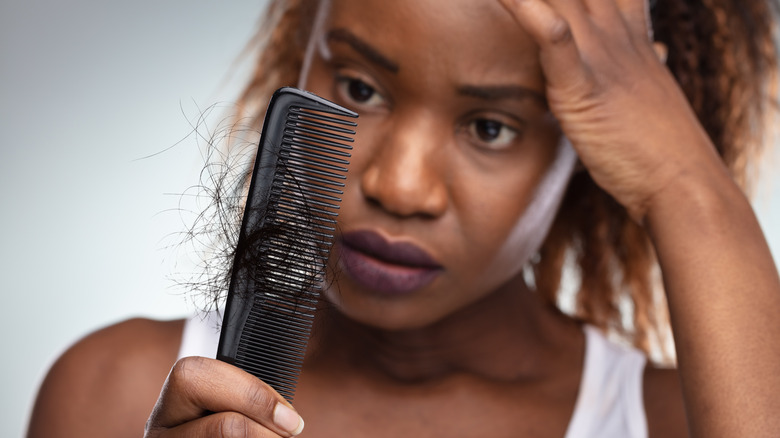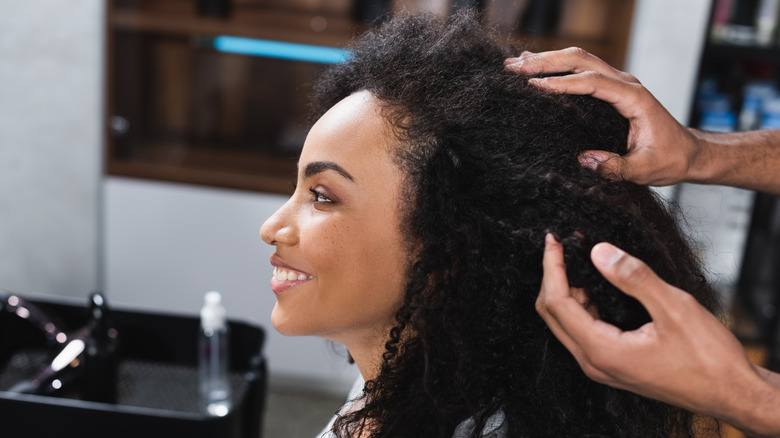What You Need To Know About Traction Alopecia And The Risk It Poses To Your Hair Health
Do you normally wear your hair in tight ponytails or braids? If that's the case, consider switching to a different hairstyle. Braids, extensions, pigtails, and other scalp-pulling hairstyles can lead to traction alopecia, a common cause of hair loss.
As its name suggests, this form of alopecia occurs in areas where the hair is constantly pulled, explains dermatologist Oma Agbai. "For example, if you wear tight ponytails, the areas around the frontal or posterior hairline could develop patches of alopecia in a band-like distribution. Commonly, there is a fringe of retained fine, wispy hairs across the hairline, which leads to the characteristic fringe sign of traction alopecia," she told Dermatology Times. In its early stages, traction alopecia may cause itching, crusting, soreness, and small bumps on the scalp.
Not long ago, comedian Amy Schumer opened up about her little-known disorder, trichotillomania. This mental health condition occurs when people pull out their hair in response to stress, among other causes. Traction alopecia is caused by constant hair pulling, too, but it doesn't have a psychological component, so it's easier to prevent and treat. The sooner you do something about it, the lower your risk of permanent hair loss.
Traction alopecia, an overlooked cause of hair loss
About 30% of women of African descent experience hair loss due to traction alopecia, according to 2018 research published in the Clinical, Cosmetic, and Investigational Dermatology journal. This disorder can affect anyone, regardless of age or sex, but it's more common in people wearing tight hairstyles like dreadlocks, cornrows, braids, or waves. The risk is even higher for those who also use chemical-based hair relaxers. Other practices, such as wearing a hijab, tight caps, wigs, or safety helmets, can contribute to traction alopecia, too.
Researchers believe that tight hairstyles affect the hair follicles, leading to inflammation. This may result in local irritation, pustules, papules, hair thinning, and ultimately, hair loss. In some cases, traction alopecia can occur years after a person has switched to a more relaxed hairstyle, notes Dermatology Times. So, if you're thinking about getting sisterlocks, you might want to reconsider your decision.
On the positive side, this disorder can be treated with antibiotics, minoxidil, and anti-inflammatory shots. The goal of treatment is to reduce inflammation and stimulate hair growth. For best results, you may also need to stop dying your hair and applying heat to it. In more severe cases, doctors may recommend a hair transplant or platelet-rich plasma (PRP) therapy.
What can you do to prevent traction alopecia?
The best way to prevent traction alopecia is to avoid tight hairstyles. However, wearing a ponytail or braids once in a while is unlikely to damage your hair; just make sure it doesn't become a habit. Thicker braids and dreadlocks are generally safer. Experts also recommend changing your hairstyle every few months or as soon as you notice any signs of discomfort, such as scalp pain and soreness.
Loose hairstyles and updos pose the lowest risk, according to dermatologist Crystal Aguh. She also advises against the use of flat irons, blow dryers, glued wigs, and chemical hair treatments. "Hair is a cornerstone of self-esteem and identity for many people, but ironically, some hairstyles meant to improve our self-confidence actually lead to hair and scalp damage," she told Johns Hopkins Medicine.
Apart from that, make sure you know when to see a doctor about daily hair loss. Any bald spots and patches of thinning hair, as well as other issues, such as flaking, itching, or pustules, might warrant a check-up. Meanwhile, give your hair a break from extensions, heat, and chemical dyes, and tweak your diet as needed. For example, you may need more protein, zinc, iron, or B vitamins. A deficiency in these nutrients can cause or worsen hair loss and affect scalp health.

